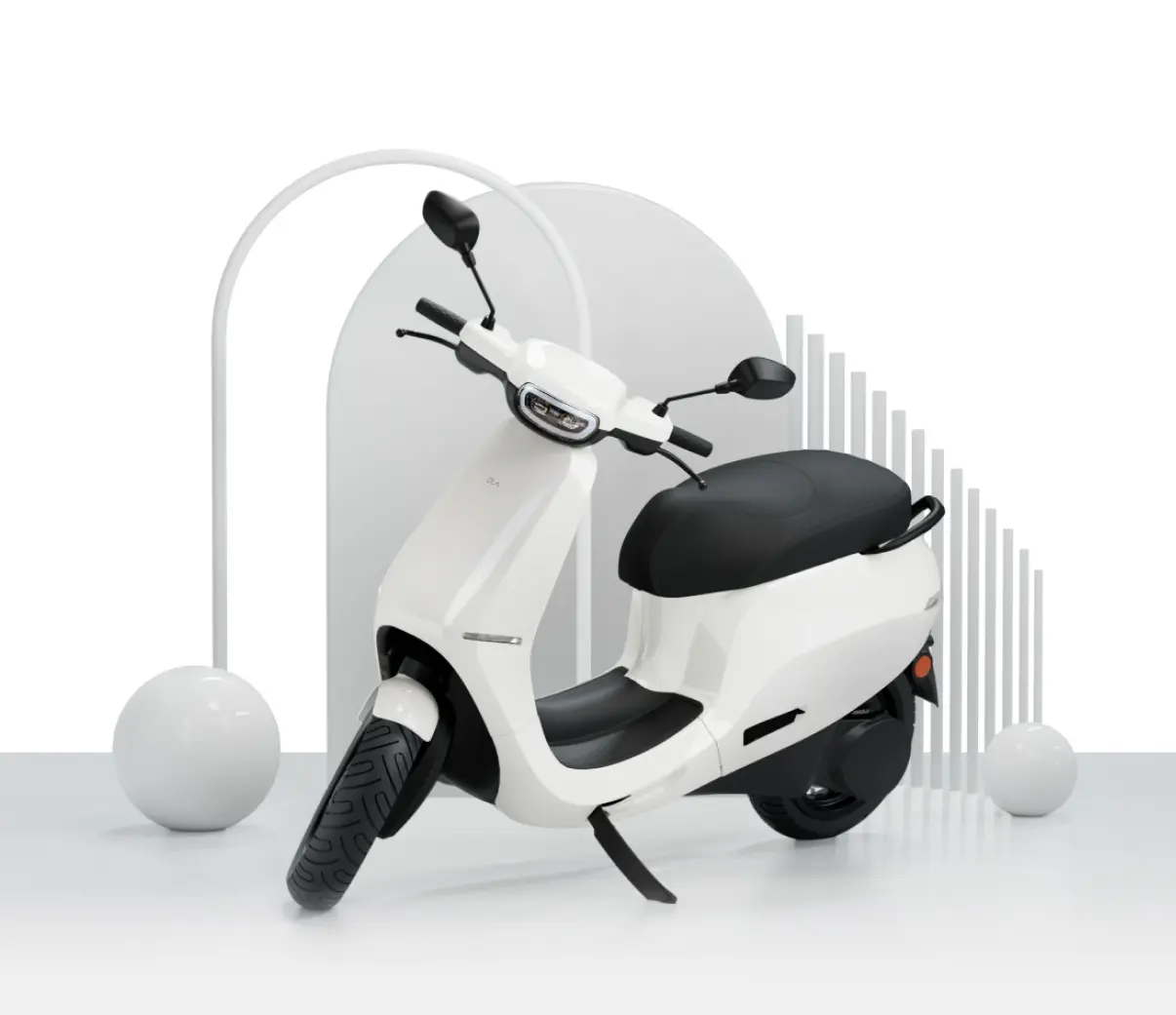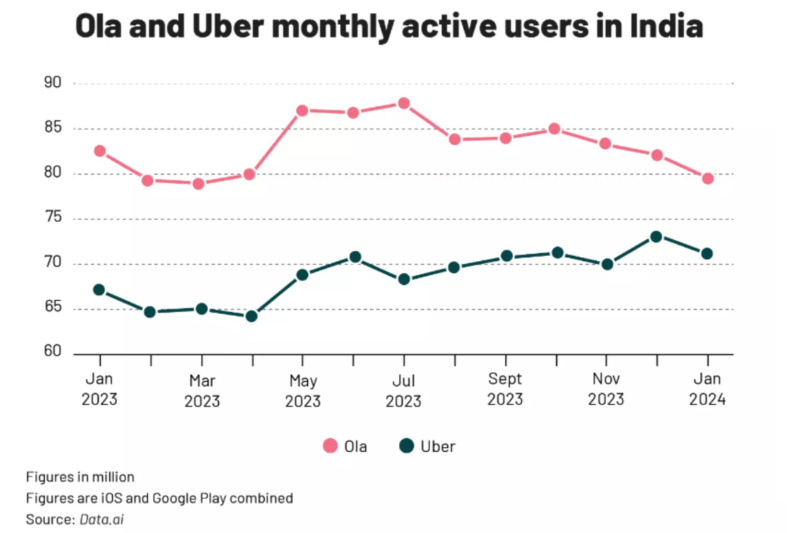Ola Shut Their International Operations Citing That They Want To Focus On Indian Business. Do They Really Want To Focus On Indian Business Or Unable To Handle The Business?

About a month ago, Ola announced its plan to shut down its international operations and focus its operations on Indian markets, driving its way back to domestic markets. One of the reasons for the company’s exit from foreign markets was its decision to focus on electric mobility in the domestic market. “The ride-hailing company is rapidly developing but remains profitable and leads its market in India. The future of mobility is electric, not just for personal mobility but also for the ride-hailing sector, and India holds immense development potential”, said the ride-hailing company.
However, the recent course of events revolving around the company emits some disturbing waves. Recently, Ola Cabs CEO Hemant Bakshi quit just three months after the ride-hailing business publicly announced his appointment, with founder Bhavish Aggarwal resuming leadership. According to the sources, the company will also undergo a restructuring that would result in at least a ten per cent decline in personnel, affecting approximately 200 employees. This top-deck shift and the overall restructuring comes when the company strives to increase profitability, with intentions of IPO.
With Hemant Bakshi, the company’s first professional CEO, stepping down, the company finds itself in the spotlight as several big questions surround cab-hailing and Ola’s future trajectory with the business.
Losses are expected to put brakes on Ola’s profitability wheels.
Bhavish Aggarwal’s ride-hailing business reported standalone losses of Rs 1,082 crore in the fiscal year 2023, according to incomplete disclosures on the company’s website. The figure is 65% lower than the previous year’s damage, but it may be cold comfort for the company, as founder and CEO Bhavish Aggarwal had anticipated profitability in FY23. The losses were primarily due to the company’s decision to write off its interests in three group businesses: used cars, food delivery, and grocery. Its efforts to defend market share against a resurgent Uber also contributed to the figures.
The company that managed food delivery experienced a significant income decline, falling from Rs 115 crore in FY22 to Rs 1.3 crore the following year. Its losses totalled Rs 106 crore. The cab-leasing and grocery operations lost Rs 387 crore and Rs 81 crore, respectively. In addition, there were expenses for interest payments on a $500 million term loan B.
These losses raises the questions about the handling of the business.
Investor slashing valuation- A Sign of Brewing Challenges!
To be fair, the ride-hailing firm has made some improvements. In Fiscal Year 23, the company reported a 63% increase in revenue and a 65% decrease in losses. However, its investor, Vanguard remained unconvinced. Now, the US investment group significantly reduced Ola’s valuation to USD 1.88 billion.

For the past years, Vanguard has continually marked down the value of its investment in the ride-hailing business. In February 2023, Vanguard valued the company at USD 4.8 billion, much lower than its highest valuation of USD 7.3 billion in December 2021. In May 2023, the US-based asset management group reduced the company’s valuation to USD 3.5 billion. Ola has raised a total of USD 3.8 billion, and Vanguard, which owns a 0.7% share, estimates the value of the firm just half of the funds it raised, i.e USD 1.88 billion.
Why does Vanguard, the world’s second-largest asset management company with USD 7.2 trillion, continue to downgrade Ola despite improved financial results? Either Bhavish Aggarwal’s firm has not met the growth forecasts set by this investor, or the latter foresees severe problems for its portfolio firm. It might be both, raising doubts about the handling of the internals of the firm.
A zigzag ride is expected to give shocks to the cab-hailing business.
While Bhavish Aggarwal’s firm has been the market leader for a long time, it is now facing increased competition from its long-term competitor, Uber. For several months, Uber, the Dara Khosrowshahi-led company, has outpaced Aggarwal’s firm in terms of downloads in India.
According to major app trackers, Uber in India is edging ahead of Ola in terms of new downloads and monthly active users. Similar websites estimate Ola’s monthly downloads to be 5 million and Uber’s to be 5.5 million. According to Data.ai, Uber has regularly outpaced Ola in India in terms of downloads over the last 9-10 months. Uber’s new downloads increased year over year, but Ola app installations slowed. According to business intelligence firm Sensor Tower, new Uber and Ola downloads in India were 20 million in 2023.
What remains promising for Ola is its advantage in overall app installations. Both Data.ai and Sensor Tower produce practically identical results. According to Data.ai, Ola has been downloaded 204 million times and Uber 166 million times in India. According to Sensor Tower, Ola has been installed over 202 million times in India, compared to 166 million for Uber.
However, they differ significantly in terms of monthly active user (MAU) base numbers. Although Ola has received more downloads in India than Uber, Sensor Tower believes that Uber has a considerably larger user base nationwide, with almost 45 million MAUs through December 2023, nearly three times Ola’s 14 million. However, Data.ai discovers that, even though the distance is closing, Ola continues to lead. According to their figures, Ola’s MAU base is around 80 million, while Uber’s is 71 million.

Again, Ola’s active user base decreased by 3.6%, while Uber’s increased by 6%. In other words, after reaching 82.56 million in January 2023, Ola’s monthly active user base fell to 79.58 million in January 2024. Uber’s revenue increased from 61.1 million to 71.1 million within the same time period. Ola’s monthly downloads fell year on year, from 1.7 million to 1.55 million in January 2024. According to Data.ai, Uber’s numbers increased from 1.57 million to 1.73 million.
Ola’s ride-hailing sales (cab bookings) increased by 63% to Rs 1,987 crore, while Uber’s revenue in the company increased by 75% to Rs 678 crore. Uber is progressively closing the gap: Ola’s sales were 2.9X higher in FY23, down from more than 3.2X in 2022. (The numbers listed here only apply to cab operations).
This comparative analysis Ola need to be careful about so that a smooth handling of the operations continue within the firm, or else, the questions will be raised!
Downsizing the company- An attempt to restructure the firm or an effort in cost cutting for the company?
The Bhavish Aggarwal’s firm has always employed a substantially more considerable number of people. It formerly had 4-5 times the number of users as Uber in India. Now, Uber may be larger in terms of organisational size.
For comparison, Uber employs 2,500 individuals in India, with at least 1,000 working in the ride-hailing business and the rest working at the company’s global technology headquarters. Bhavish Aggarwal’s firm has steadily reduced its personnel over the years. According to March Tracxn data based on EPFO filings, it is less than one-third of what it was three years ago. Uber’s India operation appears to have surpassed Ola in terms of number of people for the first time.
Uber’s market capitalisation of USD 161 billion is roughly three times that of the aggregate valuation of all ride-hailing apps worldwide. Increased market capitalisation, free cash flow, and earnings allow Uber more room to slowly develop its India presence, which may be worrying for Ola. Recently, Ola said it is expected to reduce its workforce by 10%, raising questions about the handling of operations within the company.
The ‘Jack of all trades and master of……’ attitude is hurting the company’s core. Also, the management style under Aggarwal is often criticised.
Along with business models, the founder is the one whose perspective and vision define the success of the organisation.
Many experts weigh that Bhavish Aggarwal desires to have feet on every booming business. He stays in one sector only till he finds the next lucrative technology and moves on, leaving the before on the road. Ola cab to EV To Gen AI to what’s next?
As previously said, Mr Aggarwal attempts to enter every domain that circles around the current time but may or may not succeed in reaching the final point. Ola Café, Foodpanda, Ola Cars, and Ola Dash demonstrate that entrepreneurs dive into each new subject without first examining their ability to delve deeper into it. For example, the Café shut in early 2016, a year after its debut. Three years later, in 2019, Mr Bhavish Aggarwal closed down Foodpanda, which it had purchased around the end of 2017. The used-car business, Ola Cars, and its quick commerce venture, the Dash, closed in June 2022.

According to a source acquainted with the situation, Aggarwal’s focus is divided, as evidenced by the data. This is a key factor because having the founder as the lead helped the ride-hailing firm stand out early. All group firms are concerned about the serial entrepreneur’s ability to participate fully. Also, the DRHP, filed with market regulator SEBI, specifically mentions this issue as a risk factor.
Under the heading ‘Internal risks’ on page 34 of Ola Electric’s DRHP, the document says that the company is highly dependent on Bhavish Aggarwal’s services and reputation. Therefore, any investor’s thoughts about Mr Bhavish Aggarwal may raise questions about the business’s existence.
While Ola appeared distracted by struggling verticals, Uber continued its efforts to strengthen its dominance in India’s ride-hailing market. Throughout the year, it spent money on marketing and rebuilding its team. Uber’s losses in India increased 57% to Rs 311 crore in FY23. While the figure appears to be minimal, it does not account for all costs, which may be pooled at the company’s headquarters in San Francisco. Ola tracks all of its expenses in India.
Uber India had a total income of Rs 2,666 crore in FY23, with outsourcing functions generating 75% of it. ANI Technologies, Ola’s parent company, houses Ola Financial, Ola Fleet, and new projects such as Ola Stores. In FY23, it reported a consolidated income of Rs 2,799 crore and a deficit of Rs 772 crore.
“Uber (US) has accumulated cash reserves of more than $5 billion, allowing it to make bolder advances in India than ever before. Ola’s cash cushion has decreased from $407.1 million (Rs 3,386.4 crore) in 2022 to $346.9 million (Rs 2,886.2 crore). It has increased spending in response to its competitor’s fresh marketing effort. This is one of the reasons it did not achieve company-level profitability in fiscal year 2023 and continued to be a loss-making organisation. This again raises flags about the firm’s appropriate handling.
The entry of new players in the market makes the roads tougher for Mr Bhavish Aggarwal.
Uber’s increasing interest in the Indian market is only one of the challenges Ola faces. The other issue is that new ridesharing companies are gaining ground. “The Indian market is becoming more competitive. It was originally a two-player market; currently, there are three to four participants, including many fresh upstarts.
Ola suffered from losing emphasis on its key offering. It made things in cabs a little easier. During that period, Uber redoubled its efforts to regain market share, while competitors including Rapido, BluSmart, and Namma Yatri also began to gain momentum.
In Bengaluru, for example, three-wheeler ride-hailing is split evenly among four players: Ola, Uber, Namma Yatri, and Rapido. Rapido claims to hold a lead in other southern metropolises, including Hyderabad and Chennai. Like Juspay-run Namma Yatri, Rapido is changing to a zero-commission model in which passengers pay a monthly fee to use the app. After four months of testing in Hyderabad, it introduced the identical model to the car market in October. It has started cab hailing in numerous major cities and claims to have onboarded 300,000 drivers.
Meanwhile, BluSmart, which focuses on the niche electric-sedan category, recently obtained more funding from existing investors and intends to expand its fleet from 5,500 to 8,000 vehicles. Bhavish aggarwal’s firm will require new enthusiasm, ideas, and actions to hold its dominance in the increasingly competitive cab-hailing business and push its investors to reconsider their mark-to-market strategy. Or otherwise, there are enough pointers to raise a doubt about its ‘focus and handling’ of Indian market!
Tech transition- The need for ride-hailing to incorporate the firm with AI.
Artificial intelligence is reshaping the worldwide ride-hailing market. AI is being used to improve taxi ETA (estimated time of arrival), supply/demand prediction, driver-rider communication, and customer service. This could lead to ride-hailing companies becoming significantly leaner in the near future.
As AI enters every domain, how can the ride-hailing business be spared from its claws? Already, the Indian ride-hailing firm has slashed valuations on its plate; furthermore, with robo-taxis (a product employing AI), the cars would be transferred to the books of Transportation network companies rather than being leased/owned by drivers, necessitating major capital investments. This can be one of the big challenges that Bhavish Aggarwal’s firm can face.
Last but not the least- Top-level Exodus from the company raises red flags about the culture of the company which in turn raises questions on the overall survival of the company.
Bakshi’s recent departure is not the first such top-level exit from the company. The ride-hailing firm has experienced a significant change in top executives in recent years. Many senior executives from various divisions, including Ola Cabs, Ola Cars, Ola Electric, and Ola Financial Services, have resigned. These departures have created a leadership void, making it considerably more difficult for Mr Bhavish Aggarwal to strategise and manage the current situation.
The following left the team of Bhavish Aggarwal for various reasons.
- Dinesh Radhakrishnan dealt with engineering operations across both Ola Electric and Ola Cabs.
- Mr Arun Sirdeshmukh, head of the used vehicle business Ola Cars.
- Ola’s chief marketing officer, Mr Varun Dubey and CFO Mr Swayam Saurabh.
- Ola Electric’s head of quality assurance, Joseph Thomas.
- Ola’s chief operating officer, Gaurav Porwal.
These are among those who have left the company in the last 2-3 years. Many have cited the company’s rigorous work culture as the reason for its ongoing personnel turnover.
So, what happened with Bakshi? He became CEO of cab-hailing firm in September of last year. However, the company did not confirm his position for four months, even after a news outlet reported it. In fact, an internal joke at the firm linked the lack of a formal statement to the company’s failure to retain senior executives. It went like this: “This individual will quit within months; therefore, why would he (Bhavish Aggarwal) mention it?”.
That isn’t an unfounded joke. It is not uncommon for a CXO to leave the Bhavish Aggarwal Group after only a few months. Previously, Ola Electric’s chief business officer, Sanjay Bhan, left in nine months, while Ola Cabs’ chief people officer, Susheel Balakrishnan, left in six months. Bakshi has also departed the company in seven months, as expected.
When Aggarwal chose to bring in a CEO for the company in a surprise move, it raised curiosity since he had been the sole face of the firm in its 13 years of existence. Aggarwal, according to sources, needed to focus on company’s Electric division and its IPO and wanted to transfer the extra responsibility of Ola Cabs, something that investors may not watch favourably. Aggarwal holds 35% in Ola Electric and 9% in Ola Cabs, which may have been another factor. Aggarwal’s original cab business, it was thought, was en route to self-sustainability. That said, growth had slowed and displayed signs of saturation at a lower-than-expected revenue level.
Bakshi worked for 15 years at Unilever before joining with Mr Aggarwal. The hire was in line with Aggarwal’s inclination for FMCG veterans to drive growth. But many such executives who spent long years in big companies have left Aggarwal’s team after short stints. Take the matter of Vishal Kaul from PepsiCo, Shalabh Seth from SABMiller, and Arun Srinivas from Unilever, all appointed as chief operating officers (COOs) at various points. None of them lasted more than 18 months.
Bakshi now joins these feet with the unenviable distinction of serving the shortest time among these CXOs. Those conscious of the situation at the company said Bakshi and Aggarwal’s thinking did not align regarding particular vital issues. For instance, there was a considerable debate about team-building tactics for the forthcoming fiscal year. Bakshi argued that an operations-first attitude was essential for growing Ola’s operations, whereas Aggarwal wanted to focus more on technology.
The event had put the spotlight back on Bhavish Aggarwal’s organisational volatility. “The narrative repeats repeatedly. Don’t forget that the ride-hailing firm has an appropriate 47% staff turnover rate. Half of the company leaves every year! This alone is astounding and challenges a “technology company” as one just cannot humanly convey “technology” with an employee base that churns so soon. Along with other concerns about the corporation, we shouldn’t be shocked by this outcome for the organisation.
The bottom line.
All this raises flags that the ride-hailing firm said while shutting the international markets that they want to focus on Indian markets. Do They Really Want To Focus On Indian Business Or Unable To Handle The Business?




